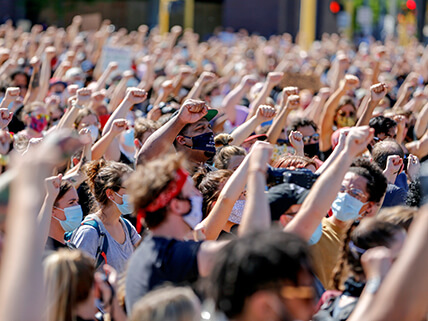Thousands of protesters raise their fists before marching from downtown Minneapolis to the site where George Floyd, who died while in police custody, was arrested, June 5, 2020.
Large-scale protests for racial justice—in particular against police brutality—erupted across the United States in late May, continuing into June. People from all walks of life, ages, and racial backgrounds joined in the demonstrations, which initially were a response to the killing by police of George Floyd, a 46-year-old African American man, during an arrest in Minneapolis, Minnesota. Floyd died while in police custody after an officer placed his knee on Floyd’s neck for more than eight minutes. A video showing Floyd—handcuffed, in pain, gasping for breath—went viral, arousing widespread outrage and condemnation of the policeman’s action. The four officers involved were quickly fired from the Minneapolis police force, and one has been charged with murder and manslaughter.
The level of attention to the killing of George Floyd signifies a historic watershed in terms of the issue of policing, racism, and African Americans. It occurred on the heels of another murder of a young, unarmed African American, Ahmaud Arbery, in Georgia, and the police shooting of Breonna Taylor in Louisville, Kentucky, during a “no-knock” raid. As one common protest sign simply declared: “Enough!” The protests that originated in Minneapolis soon spread nationwide as hundreds of thousands participated. Many of the demonstrations were organized by the Black Lives Matter movement.
Rioting and looting—distinct from the protests—also occurred in many American cities, including Atlanta, Baltimore, Chicago, Los Angeles, New York, Philadelphia, and Washington, D.C. Vandalism and arson were perpetrated, as police cars and random buildings were burned, stores were ransacked, and significant property damage was wrought. Amidst the mayhem, police confronted both protesters and lawbreakers, sometimes employing nonlethal measures such as rubber bullets, tear gas, and pepper spray. Over the course of two weeks, about a dozen people were killed, including police officers. While most protests were peaceful, authorities responded to the growing unrest. In two dozen states, National Guard troops were eventually brought in to help protect lives and property. By the third week of June, the unrest had tapered off.
The passionate demands for racial justice surrounding George Floyd’s death have spurred efforts at police reform: to cut police budgets, end the worst abuses, improve accountability, and overcome racism. Opposition has risen to the concept of “qualified immunity,” which shields police from being sued for violations of civil rights. Restrictions on the use of “choke holds” and “no-knock warrants” are being implemented. One unintended consequence of the mass demonstrations may be a contribution to spikes in COVID-19 cases. Although many protesters wore masks, caution regarding social distancing was often abandoned as Americans took to the streets. Many public health authorities endorsed the protests, after months of emphasizing social distancing and of banning public gatherings of even small groups.
Image credit: © Eric Miller/Reuters
Related Links:
- Seven Days in Minneapolis: A Timeline of What We Know about the Death of George Floyd and Its Aftermath
Local coverage of the events surrounding the killing of George Floyd and the resulting protests from the “epicenter,” Minneapolis.
(Source: MinnPost.com; updated June 1, 2020) - Protesters Break Curfew on Another Night of Fury and Frustrations over George Floyd’s Killing
News coverage from the first weekend of unrest following the killing of George Floyd.
(Source: CNN.com, May 31, 2020) - Atlanta Mayor’s Speech to City during Violent Protests
Text of speech by Mayor Keisha Lance Bottoms of Atlanta, Georgia, whose city was the site of both protests and rioting.
(Source: 11alive.com, May 30, 2020) - Who’s Behind the Violence at George Floyd Protests in US?
A look at the difference between those engaged in protests and those responsible for rioting.
(Source: VOA News, June 4, 2020) - 10 Experts on Where the George Floyd Protests Fit into American History
A group of historians and other academics try to put the present protests in historical context.
(Source: Time.com, June 4, 2020) - Factbox: What Changes Are Governments Making in Response to George Floyd Protests?
This article documents a number of concrete actions, such as police reform initiatives, being taken in response to the mass protests.
(Source: Reuters, June 10, 2020) - Definition of Systemic Racism in Sociology
An essay on systemic racism as “both a theoretical concept and a reality.”
(Thoughtco.com; updated June 11, 2020) - Stories and Data: Reflactions on Race, Riots, and Police
Careful argument about the role of racism in policing.
(City Journal, June 14, 2020) - Insured Losses from Riots Reach “Catastrophe” Levels, May Rival Record
Early estimates of damage from the widespread riots indicate they may become the costliest civil disorder in U.S. history.
(ClaimsJournal.com, June 2, 2020)




